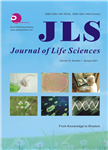Angiogenesis at Different Stage of Pregnancy Ingoatplacenta
Angiogenesis at Different Stage of Pregnancy Ingoatplacenta作者机构:Cell Biology and Embryology Animal Anatomy Department School of Agronomy andVeterinary Medicine National University of Rio Cuarto Argentina Area Electron Microscopy Animal Pathology Department School of Agronomy and Veterinary Medicine National University of Rio Cuarto Argentina
出 版 物:《Journal of Life Sciences》 (生命科学(英文版))
年 卷 期:2015年第9卷第8期
页 面:391-398页
学科分类:0710[理学-生物学] 090502[农学-动物营养与饲料科学] 07[理学] 0905[农学-畜牧学] 09[农学] 071003[理学-生理学]
主 题:Angiogenesis Goat Placenta VEGF
摘 要:The increase intransplacental exchange depends primarily on the great development of the placental vascular bed. The aim of this study was to evaluate the pattern of placental vascular development at day 50 and 100 of pregnancyin goats and the relationship with the vascular endothelial growth factor (VEGF) immunolocalization. The placental morphometric variables: capillary area density, capillary perimeter density, capillary number density and average capillary perimeter of the caruncular (CAR) and cotyledonary (COT) tissues were measured at day 50 (n = 5) and 100 (n = 5) of gestation. Also, the immunolocalization of VEGF was performed. In the CAR and COT tissues a significant increase of capillary area density and capillary perimeter density at day 100 of the gestation was observed. In the COT tissue, this was due to the increase in the capillary number density; however in the CAR tissue this was due to the increase in the capillary size. We can conclude that in both tissues there were different strategies to increase the capillary area and, thereby, the nutrients exchange. The immunolocalization of VEGF in the COT tissue showed the endothelial cells of blood vessels and trophoblastcells surrounding the villi intensely inmunostained, which would indicate the involvement of VEGF in the placental vascular development.



